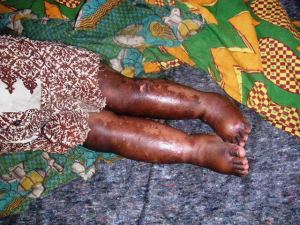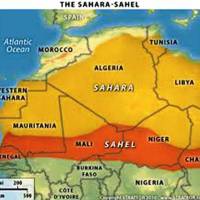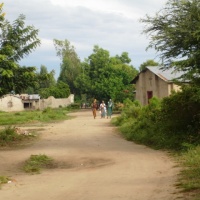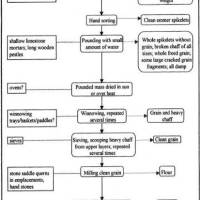“The quantities of meat our men devour is quite astounding. They boil as much as their pots will hold, and eat till it becomes physically impossible for them to stow away any more…”
In a previous post – ‘Cuisines and Crops of Africa, 19th Century – The Limits of Pastoralism as a Lifestyle’ – The explorer Speke described the eating and fasting habits of Somali pastoralists, whose ‘fast-feast’ style of eating was seen to be directly linked to their spartan lifestyle.
Similar extremes of eating are also described by Livingstone in the Zambezi river basin of south-central Africa, where he traveled in the mid-19th. Century, (Missionary Travels and Researches in South Africa) – sections quoted below.
Such fast-feast eating patterns can still be found in Africa, either on a seasonal basis or directly linked to crop failures or other disasters. That is because subsistence farmers are generally so closely dependent upon their annual crop harvests for their daily food that crop failure or fighting can spell malnutrition for part of the year.
As well, even during good years, family consumption during the dry season may be limited to starches such as yams, sweet potatoes, and manioc with a corresponding lack of fresh vegetables or fruits. Increasingly, too, because of war, displacement and other problems, mothers here feed their weaning infants porridge made of manioc, which is a recipe for nutritional problems. The results commonly lead to nutritional diseases, the two most common forms found throughout the third world being marasmus and kwashiorkor.
Marasmus is associated with moderate to severe protein-energy deficiency that leads to extreme muscle and tissue wasting; ‘Voracious eating’, of the type described below by Livingstone, is often associated with marasmus.

On the left, 3 cases of marasmus - and on the right, one case of apparent kwashiorkor. Source: George Grenfell and the Congo. a history and description of the Congo 1908
Kwashiorkor is a more complicated nutritional disease that includes deficiencies in micronutrients, in addition to protein and energy deficiencies. This is the form most commonly see here in Burundi, especially during the lean months and, in the 1990’s, during the war years in refugee and displacement camps:
These are not recent problems. Colonial records mention the same symptoms, which were often confused with venereal diseases, because causes and symptoms of nutritional diseases can be similar and this was not well understood until the last few decades.

School children in Eastern Congo, early 20th. Century. Virtually all are apparently suffering from marasmus, and many also from parasites, for which swollen bellies are also an indicator.
To help compensate for extremes of food availability, what we would call ‘binge eating’ has been commonly practiced during the period of ample food supplies, which can result in stored body fat to be used during the dry season ‘fasting’ period. Unfortunately, small children are unable to process and store body fat in the same way as adults and thus are most vulnerable to these nutritional diseases.
Binge eating, often associated with long periods of lean findings, was perhaps most noticeably seen amongst the Khoi hunter-gathers of southern Africa, where the stored fat in the buttocks and stomach area on women caused curiosity – and some alarm – amongst colonial explorers:
It is within this context that the following eating practices in south-central Africa, described in 1864 by Livingston, can be best understood. In addition, as he is talking about the consumption of an elephant – as much as possible of the beast must be eaten, because in a tropical climate the meat will putrefy in a very short period of time:
The quantities of meat our men devour is quite astounding. They boil as much as their pots will hold, and eat till it becomes physically impossible for them to stow away any more.
An uproarious dance follows, accompanied with stentorian song; and as soon as they have shaken their first course down, and washed off the sweat and dust of the after performance, they go to work to roast more.
A short snatch of sleep succeeds, and they are up and at it again; all night long it is boil and eat, roast and devour, with a few brief interludes of sleep.
Like other carnivora, these men can endure hunger for a much longer period than the mere porridge-eating tribes.
Our men can cook meat as well as any reasonable traveller could desire; and, boiled in earthen pots, like Indian chatties, it tastes much better than when cooked in iron ones.
Cynthia Bertelsen has also put up an excellent blog touching on some of these issues and is well worth a read: Hunger, Starvation, Famine and the Sweep of Human History.
I would also like to mention that today’s blog was in part inspired by information received yesterday from IRIN (Integrated Regional Information Networks ) about recent breakthroughs in addressing these serious problems:
Fortified flour and chewing gum – new approaches to malnutrition
NAIROBI, 9 November (IRIN) – Some of the most widespread forms of malnutrition can best be reduced by delivering micronutrients and fortifying food in new, cost-effective ways, in combination with community outreach work, experts have said.
Approaches could range from the obvious – adding iron to flour – to the novel, such as vitamin-enriched chewing gum, a Nairobi conference heard.
Vitamin A, iron and iodine are the most important micronutrients in global public health terms, according to the World Health Organization (WHO), particularly for children and pregnant women in poor countries.
Vitamin A deficiency affects more than half of all countries, especially in Africa and Southeast Asia, and it is “especially important where under-five mortality is high,” Sue Horton, a malnutrition economist, told the conference.
The conference on nutrition, held in Nairobi on 3 November, was organized by Danish think-tank The Copenhagen Consensus Center (CCC).
CCC has ranked micronutrient supplements as a top development priority following findings of a study it commissioned in 2008 to identify the best ways to spend aid and development money.
Provision of Vitamin A, it added, to children aged six months to five years every four to six months could reduce mortality by 23 percent…
Nutritional deficiencies can be cured with proper food. Very simple and as these kids show, very achievable.
Related articles
- The 10 Most Important Crops In The World (businessinsider.com)
- PepsiCo’s Chick Pea Plan Includes Taking On Famine (nytimes.com)
- Palm Oil Family Production in Congo (lokoleyacongo.wordpress.com)
- Plantains and Bananas: “The Staff of Savage Life” (dianabuja.wordpress.com)
- Small seed packets could play big role in Africa’s battle against drought (guardian.co.uk)
- Cuisines and Crops of Africa, 19th Century – Zambezi River Watershed in Southern Africa (dianabuja.wordpress.com)
- Trading States of the Congo River Basin during the19th-century in Africa (egrejeen.wordpress.com)






























Pingback: A Taste of 2012 – Top Posts Favor Colonial Era; Food; Ancient Egypt | DIANABUJA'S BLOG: Africa, the Middle East, Agriculture, History & Culture
yeah, we’ve to change sth, there are too many people suffering!
LikeLike
Pingback: Most Popular Blog Pages – Why?! « Dianabuja's Blog
We have created a cookbook which features 139 recipes from food bloggers around the world to raise funds for the School Meals Programme so that kids can attend school and in some of the poorest countries take home food for their families. Children are our future.
LikeLike
Maria – regarding fortified foods, here is the link for a document put out by WFP, on fortified food preparation – due to poverty, seasonality, military incursions, etc – fortified foods do offer a critical life line, even though reliance on local produce would be the best solution:
Click to access wfp_recipes.pdf
LikeLike
This is a little off topic, but it is Burundi-food related…
Whenever our cook makes isombe he uses some sort of small hard-ish orange thing with brown-ish bottoms… I think it is called ibigazi. Do you know what it would be called in French or English? Or simply what it is?
LikeLike
Yolanda – Those would be indigenous eggplants, sometimes called ‘garden eggs’ in English, which are found throughout the tropics and have a much more piquant – and are less watery – than northern hemisphere eggplants. They are a central feature of cooking in West and Central Africa – in sauces and also sometimes in meat dishes.
Always happy to try and answer questions!
LikeLike
Thanks for answering questions! I don’t know that I described it well, since I knew what garden-eggs/eggplants were. This one has a pit in the middle, is about an inch long, and is very fiber-y. It is bright orangey-red and some have some brown.
I tried searching again – this time time with faster internet (yeah!) and thinking things through (I am terrible at Kirundi). Trying the singular, ikigazi, I got some results, but they really don’t mean much to me.
this dictionary: http://www.websters-online-dictionary.org/translation/Kivinza/ikigazi says it’s an oil palm?
I also found this: http://www.metafro.be/prelude/view_plant?pi=05270&cat=V – which has a picture of what I am talking about. This seems to list it as a traditional medicine in some places?
LikeLike
Yolanda, now I know the recipe you’re talking abut – it is ‘Isombe y’umwamba’. And you’re right, those are oil palm nuts. The dish is actually Congolese, and is found in both Congos. Here are the ingredients as I know them:
– Isombe (manioc leaves), well pounded
– Oil palm nuts (crushed and then the juice squeezed out – it is the juice that is used)
– Crushed, fresh peanuts, mixed in with the isombe
– Leeks, pounded together with the isombe
– Garlic, also pounded with the isombe
– A small amount of oil of palm
It makes a very tasty relish to eat with a pate of manioc, maize, sorghum or millet.
LikeLike
Thanks! You are right, it is tasty. Definitely one of my favourite day to day dishes here – which is why I was curious about it.
LikeLike
Yolanda, you are welcome. I will include this recipe in part 2 of my blog about Batwa pygmy potter-making and use, thanks for the questions.
LikeLike
With so many people suffering from malnutrition, fortified flour and chewing gum offer a solution. On the other hand, can they be effective without the education about better diet and locally protein/vitamin available plants, provision of safe drinking water, quality health services etc. or during the war years?
LikeLike
Maria – You are (in my mind) quite correct. The difficulty is the gap between the illnesses and the deaths on the one hand – and the longer-term training and other needed inputs on the other. chewing gum and fortified flour offer ‘stop-gap’ solutions in the meantime. Though, with increasing numbers of persons, globally, turning to wheat products, fortified flower is less of stop-gap and more of a needed input. also, with fortified maize flour and other fortified products – including iodized salt, as iodine deficiency continues to be a grave problem in some Third World areas.
LikeLike